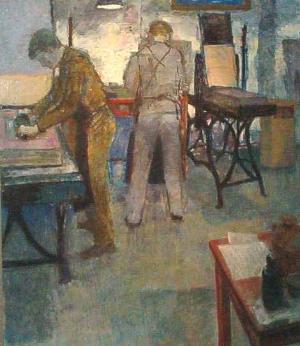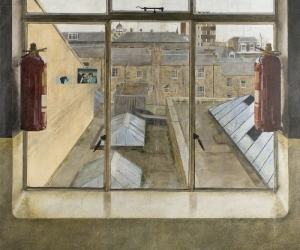Foundations
An exhibition to celebrate the 125th anniversary of Duncan of Jordanstone College of Art & Design
Matthew Building foyer, 25 October - 28 November 2013
Mon-Fri 9am-5pm Sat 12pm-5pm
 Duncan of Jordanstone College of Art & Design is now one of the largest in the UK, yet it began with just one member of staff and two small rooms as part of Dundee Technical Institute. This display by the University’s Museum Services marks the 125th anniversary of the College by featuring artworks depicting the buildings that have housed it over the years.
Duncan of Jordanstone College of Art & Design is now one of the largest in the UK, yet it began with just one member of staff and two small rooms as part of Dundee Technical Institute. This display by the University’s Museum Services marks the 125th anniversary of the College by featuring artworks depicting the buildings that have housed it over the years.
The Dundee Technical Institute was founded by jute millionaire Sir David Baxter. On his death in 1872 he bequeathed £20,000 to found a mechanics institute, but it was not until financial support was offered from University College Dundee (founded by David’s sister Mary Ann Baxter in 1881) that building work could commence. The Institute opened in 1888 with George Malcolm employed to teach drawing. More advanced art was introduced in 1892 when Thomas Delgaty Dunn was employed to teach Fine Art, Modelling & Design.
By the early 1900s there were over 1000 students enrolled at the Technical Institute and overcrowding had become a serious problem. A major fund-raising campaign was launched and in 1907 a new site on Bell Streetwas purchased. The new building (opened in 1910) was renamed Dundee Technical College & School of Art, and boasted six times the space of its predecessor.
Image left: Lithography Room, Bell Street by Dennis Buchan, 1958 (DUNUC ARTS:2096)
In 1909, local businessman James Duncan of Jordanstone died leaving some £60,000 to found a “School of Industrial Art” to be known as “the Duncan of Jordanstone Art School”. The Technical College & School of Art believed they should be the recipients of this money, but Duncan had specified in his will (made in 1899) that the new school should be separate from the Technical Institute. By the time Delgaty Dunn retired in 1927 there was still no agreement reached. His successor, Francis Cooper, took up the fight and in 1933 the Educational Endowments Commission for Scotland intervened to reach a solution. Their report led to a complete restructuring of the College as Dundee Institute of Art & Technology, with a separately run Dundee College of Art as one half of this. It was also decided that a new site was to be found for a purpose-built art college.
 By 1935, thanks to Francis Cooper’s persistence, the battle for the Duncan of Jordanstone bequest had been won and a location found for a new building, here on the Belmont estate. A national architectural competition was held to select a design but the start of the Second World War caused all work on the project to be stopped. Finally in 1953 the foundation stone was laid for the new building. Although the first part opened in 1955, it would be another nine years before the college was completed.
By 1935, thanks to Francis Cooper’s persistence, the battle for the Duncan of Jordanstone bequest had been won and a location found for a new building, here on the Belmont estate. A national architectural competition was held to select a design but the start of the Second World War caused all work on the project to be stopped. Finally in 1953 the foundation stone was laid for the new building. Although the first part opened in 1955, it would be another nine years before the college was completed.
Francis Cooper retired in 1955 and painter Hugh Adam Crawford was appointed to succeed him. As the new building was gradually occupied, the College’s reputation increased considerably. In 1962 it finally took on the name of its benefactor and became known as Duncan of Jordanstone College of Art. Crawford retired in 1964, and the new Art College building was eventually named in his honour.
Image right: View from Crawford Building by Carlo Pedreschi, c.1976 (DUNUC ARTS:2338)
Crawford was succeeded by architect Chessor Matthew, and under his leadership the college grew so rapidly that by the early 1970s a second building was urgently required. Opened in 1974, it would later be named in his honour.
Since then the College has continued to operate in these two buildings. In 1975 a significant change occurred when the Dundee Institute of Art & Technology was dissolved to create two separate bodies, Dundee College of Technology (now the University of Abertay) and Duncan of Jordanstone College of Art. Finally, almost 70 years after James Duncan’s death, Dundee had an independent art college.
Since the establishment of an independent University of Dundee in 1967, the Art College had worked closely with its near neighbour and the two would become ever closer during the 1970s and 1980s. By 1988 the University was validating all degrees awarded by the College and the inevitable next step was a formal union between the two, which took place in 1994. One of the key points of agreement was that the College would keep its own distinct identity and (vitally) its name, which in 1996 was changed to Duncan of Jordanstone College of Art & Design.
All of the artworks shown in this exhibition are from the Duncan of Jordanstone College Collection, managed by Museum Services.